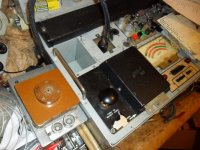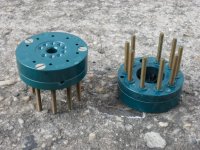You can't know, unless they are so well used that they have burn marks on the glass or are losing emission. A new valve and one with a few thousand hours' use cannot be distinguished, except perhaps by a slight darkening of the glass - but that is within the range of glass colour of new ones anyway as different makers used slightly different glass.
Long story short: You don't know. Ebay is all about buyer beware.
Do you have a tube tester? If so, test the tubes.
If you take a careful look at the tubes, you might be able to see if the glass has dark spots, maybe some areas have turned slightly brown, maybe some migration of the getter, or maybe the getter has shrunk like it's been burned away. All those would be signs of a used tube. But that depends on the tube type.
Sometimes you can tell if a tube is used by the condition of the lettering on it. Amperex, Mullard and Telefunken tubes had white lettering on the glass that would fade and turn beige/brown with the heat from operation. If the lettering is bright white then the tube could be unused or close to it.
RCA tubes had red lettering that would turn a dull orange with use.
GE output tubes (like 6L6GC, 6550A, etc.) had white lettering that would fade with use.
Also, many output tubes have a getter flash that would turn sort of a milky pink/brown with use.
Many other brands had lettering that didn't fade with use, so are harder to judge.
Maybe some other folks have more (better?) ideas on this.
--
Do you have a tube tester? If so, test the tubes.
If you take a careful look at the tubes, you might be able to see if the glass has dark spots, maybe some areas have turned slightly brown, maybe some migration of the getter, or maybe the getter has shrunk like it's been burned away. All those would be signs of a used tube. But that depends on the tube type.
Sometimes you can tell if a tube is used by the condition of the lettering on it. Amperex, Mullard and Telefunken tubes had white lettering on the glass that would fade and turn beige/brown with the heat from operation. If the lettering is bright white then the tube could be unused or close to it.
RCA tubes had red lettering that would turn a dull orange with use.
GE output tubes (like 6L6GC, 6550A, etc.) had white lettering that would fade with use.
Also, many output tubes have a getter flash that would turn sort of a milky pink/brown with use.
Many other brands had lettering that didn't fade with use, so are harder to judge.
Maybe some other folks have more (better?) ideas on this.
--
Pretty interesting topic, because it is almost never discussed. Everybody assumes that NOS means they are new but old (how clever am I!), but I see them as a pretty easy chance to scam. Specially if a dirty old rusty valve is meant to be new.
What surprise me is seeing people getting tubes very confident, while my approach to things in life is "If it cannot be checked, you better assume it is not OK".
What surprise me is seeing people getting tubes very confident, while my approach to things in life is "If it cannot be checked, you better assume it is not OK".
Quite a few people on eBay don't really know what NOS means, but they still apply it to every vacuum tube they sell. Very little for sale on eBay is actually new old stock.
This is my experience also. There are some good sellers out there, especially those who have always sold valves going back decades and who do genuinely have significant old stock in original boxes. But some sellers put NOS in the description even if the picture tells otherwise. I have even had to advise sellers to withdraw items that were obviously faulty - like a GZ34 I saw being sold the other week with the getter turned white
It's definitely a case of buyer-beware. Know what you're paying for and don't pay over the odds.
IMO this depends entirely on the reputation and knowledge of the seller. I've had only one problem with tubes not being as represented on eBay, because I am careful. Know your seller, and check those ratings. I've bought many NOS tubes on eBay, some American, and quite large a range of ex Soviet types with a smattering of German Post Office tubes as well.
I've purchased tubes from sellers in the Ukraine, Lithuania, Russia, Germany, France, Holland, the U.K and U.S without any issues.
I've purchased tubes from sellers in the Ukraine, Lithuania, Russia, Germany, France, Holland, the U.K and U.S without any issues.
Some of the safest sellers on ebay are those who have genuinely found a box of valves when emptying their deceased/ageing relative's lofts/sheds/cupboards. Need a good picture of the valve ideally with the appropriate box. The ones to be wary of are those who seem to be selling lots of valves yet are not registered as business sellers (and some of the business sellers too).
Does that mean that they all worked just right, or does it means that you are sure they were true NOS?.....without any issues.
true NOS
The only guaranteed truth is that they're old.
Regarding marks on NOS tube pins, if you see any, they were most likely made after leaving the factory. Manufactures used "production sockets" that were designed for many insertions and removals and left no visible marks. I actually have some of them that I acquired from my friend's testing lab when it closed. And they originally came from the RCA plant in Harrison New Jersey after it shut down many years ago. I also have some of the nice (and expensive) Westinghouse panel meters from there too. Anyway, I found some pictures of one on the web.
Attachments
Does that mean that they all worked just right, or does it means that you are sure they were true NOS?
Based on condition and packaging with a very few exceptions NOS, in all cases tubes have been good. I buy from sellers with good reputations, but there are also plenty who are questionable. I tend to go back to the same sellers when possible.
I also purchase good used tubes from time to time, these are more risky of course, but often the prices on rare types make it worth the risk.
NOS can be misleading as we've said many times. The only way to know how a tube behaves is to test it!
A used tube can test better than a new in box one - and quite frequently does. All depends how strong the tube was in the first place and how much use it's had.
Tubes with no boxes can be equally misleading. One can be a perfect bulk-packed tube. Another can have come out of a computer and barely wake up a tube tester with a breath of life as it expires and goes to meet its maker. Thinking 12B4 here for example. Both look new.
A good dealer will WILLINGLY give you the accurate test results on a calibrated tester. Other dealers won't go beyond "tests good". That can mean 61% which is somewhere between an expiring sigh in your equipment and a well aimed shot at the bin.
Andy
A used tube can test better than a new in box one - and quite frequently does. All depends how strong the tube was in the first place and how much use it's had.
Tubes with no boxes can be equally misleading. One can be a perfect bulk-packed tube. Another can have come out of a computer and barely wake up a tube tester with a breath of life as it expires and goes to meet its maker. Thinking 12B4 here for example. Both look new.
A good dealer will WILLINGLY give you the accurate test results on a calibrated tester. Other dealers won't go beyond "tests good". That can mean 61% which is somewhere between an expiring sigh in your equipment and a well aimed shot at the bin.
Andy
An acquaintance of mine used to do TV repair, and gave me near 1000 tubes which were mostly in original boxes.
Nearly 1/2 of them ended up having been used as revealed by testing them.
One test that seems to separate fairly good used tubes from new ones is lowering the filament voltage 10% and watching the response of the tester. If the response drops more than 10% I figure they are used.
There is probably no way to measure the difference in a true NOS and a tube with little use.
Nearly 1/2 of them ended up having been used as revealed by testing them.
One test that seems to separate fairly good used tubes from new ones is lowering the filament voltage 10% and watching the response of the tester. If the response drops more than 10% I figure they are used.
There is probably no way to measure the difference in a true NOS and a tube with little use.
Nor it is possible, as there are some fake US NOS tubes, that are made in China.The only guaranteed truth is that they're old.
You can not plug and play a NOS tube in the amp, as the cathode go to sleep after 6 month or so.Hello,
Let's say I get some vacuum tubes from ebay, supposedly NOS. When received, I plug them on the amplifier and it works. OK.
How do I know these are really new old stock tubes, and not tubes that have 3.000 hours of use?
Best regards,
Regi
Before using a NOS tube, you had to heat the tube to awake the cathode and clean some possible gas built inside the tube over the years.
Hope this help.
Last edited:
Nor it is possible, as there are some fake US NOS tubes, that are made in China.
Well. the Chinese have also their New Old Stock I guess. The Chinese 6SL7 looks really old, like it's done with aged parts. It might become a classic someday, who knows.
- Status
- This old topic is closed. If you want to reopen this topic, contact a moderator using the "Report Post" button.
- Home
- Amplifiers
- Tubes / Valves
- Second-hand or NOS tubes?

